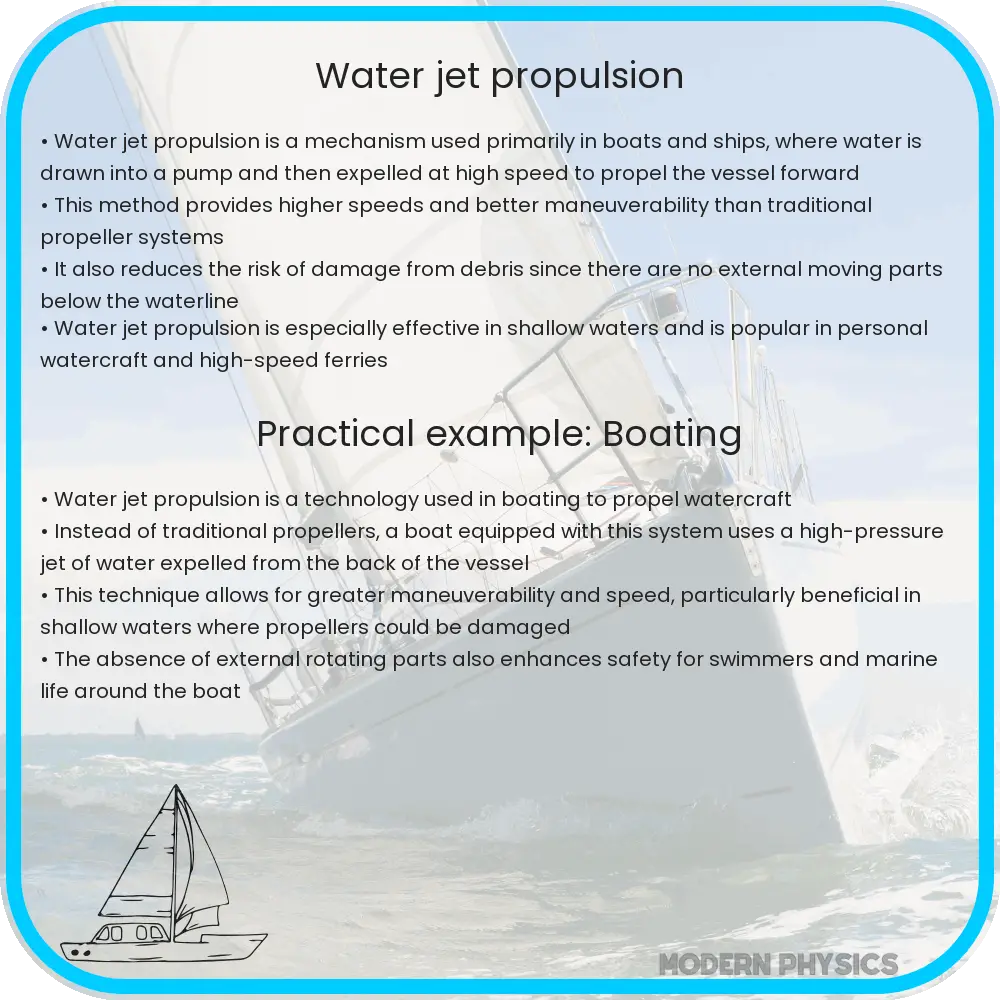Explore the efficiency and advanced physics of water jet propulsion in marine transportation, highlighting its advantages, challenges, and future.

Understanding Water Jet Propulsion: The Future of Marine Transportation
Water jet propulsion represents a significant advancement in marine transportation technology. This method of propelling boats and ships is highly efficient, offering numerous advantages over traditional propulsion methods. It operates on the principle of jet propulsion, an application of Newton’s third law of motion. Essentially, water jet propulsion systems draw water from beneath the vessel and expel it at high velocity through a nozzle at the stern, propelling the vessel forward.
How Does Water Jet Propulsion Work?
The core of water jet propulsion is the impeller, a rotor used to increase the pressure and flow of a fluid. In water jet systems, impellers are powered by a marine engine. The impeller draws water in and then accelerates it through a narrowing pipe, increasing its speed significantly. This high-speed water is then ejected through a small nozzle at the rear, creating thrust in the opposite direction. The reaction to this force moves the vessel forward. The simplicity and efficiency of this process make it a preferred choice in many modern marine applications.
Advantages of Water Jet Propulsion
- High Efficiency: Water jet propulsion systems are designed to be incredibly efficient at converting engine power into thrust, especially at high speeds.
- Enhanced Maneuverability: These systems allow for rapid changes in direction and speed, making them ideal for emergency and rescue vessels.
- Shallow Water Operation: Unlike propellers, water jets do not extend below the hull, allowing vessels to operate in shallower waters without the risk of grounding.
- Safety: With no external propeller, water jets reduce the risk of injury to marine life and humans, as well as damage from debris.
The Physics Behind Water Jet Propulsion
At the heart of water jet propulsion is the conservation of momentum, described by Newton’s third law: for every action, there is an equal and opposite reaction. When water is expelled at high velocity through the jet nozzle, it creates a ‘reaction force’ in the opposite direction, propelling the vessel forward. The efficiency of this system is influenced by various factors, including the velocity of the expelled water and the mass flow rate.
Water jet propulsion also involves complex fluid dynamics. The Bernoulli principle, which states that an increase in the speed of a fluid occurs simultaneously with a decrease in pressure or potential energy, plays a crucial role. As the impeller accelerates the water, its pressure decreases, facilitating the high-speed ejection needed for propulsion.
Energy Considerations and Environmental Impact
One of the notable advantages of water jet propulsion is its environmental friendliness. This system produces fewer vibrations, noise, and emissions compared to traditional propeller systems. The absence of a propeller reduces the risk of oil leakage and damage to marine ecosystems. Additionally, the high efficiency of water jets translates to lower fuel consumption, reducing the carbon footprint of marine vessels.
Integrating Water Jet Propulsion with Modern Vessels
Water jet propulsion is not just limited to small, high-speed boats. Its integration into larger vessels, including ferries and even some naval ships, is a testament to its versatility and efficiency. Modern engineering has allowed these systems to be scaled up, providing sufficient thrust for larger vessels while maintaining the benefits of maneuverability and environmental safety.
Challenges and Limitations
Despite its advantages, water jet propulsion is not without challenges. The initial cost of installation can be higher than traditional propulsion systems, which may deter some operators. Additionally, the efficiency of water jet systems tends to decrease at lower speeds, making them less suitable for vessels that operate predominantly at slow speeds. Maintenance can also be more complex, requiring specialized knowledge and parts.
Innovations and Future Prospects
The future of water jet propulsion is bright, with ongoing research and development aimed at overcoming its current limitations. Innovations in materials and design are making these systems lighter, more durable, and more efficient. Integration with hybrid and electric power sources is also a promising development, aligning with global efforts to reduce carbon emissions in the maritime industry.
Conclusion
Water jet propulsion represents a significant leap forward in marine transportation technology. Its principles of operation, rooted in fundamental physics, offer a blend of efficiency, safety, and environmental friendliness that is increasingly important in our modern world. While challenges exist, the continual advancements in this technology promise a wider adoption across various types of marine vessels. As environmental concerns and efficiency demands grow, water jet propulsion stands out as a key solution for the future of marine navigation, blending speed, safety, and sustainability in a remarkable way.
In conclusion, water jet propulsion is more than just an alternative to traditional marine propulsion methods; it is a forward-looking solution that addresses many of the challenges faced by the maritime industry today. Its role in shaping the future of marine transportation cannot be overstated, as it offers a path towards more sustainable, efficient, and safe maritime operations.
